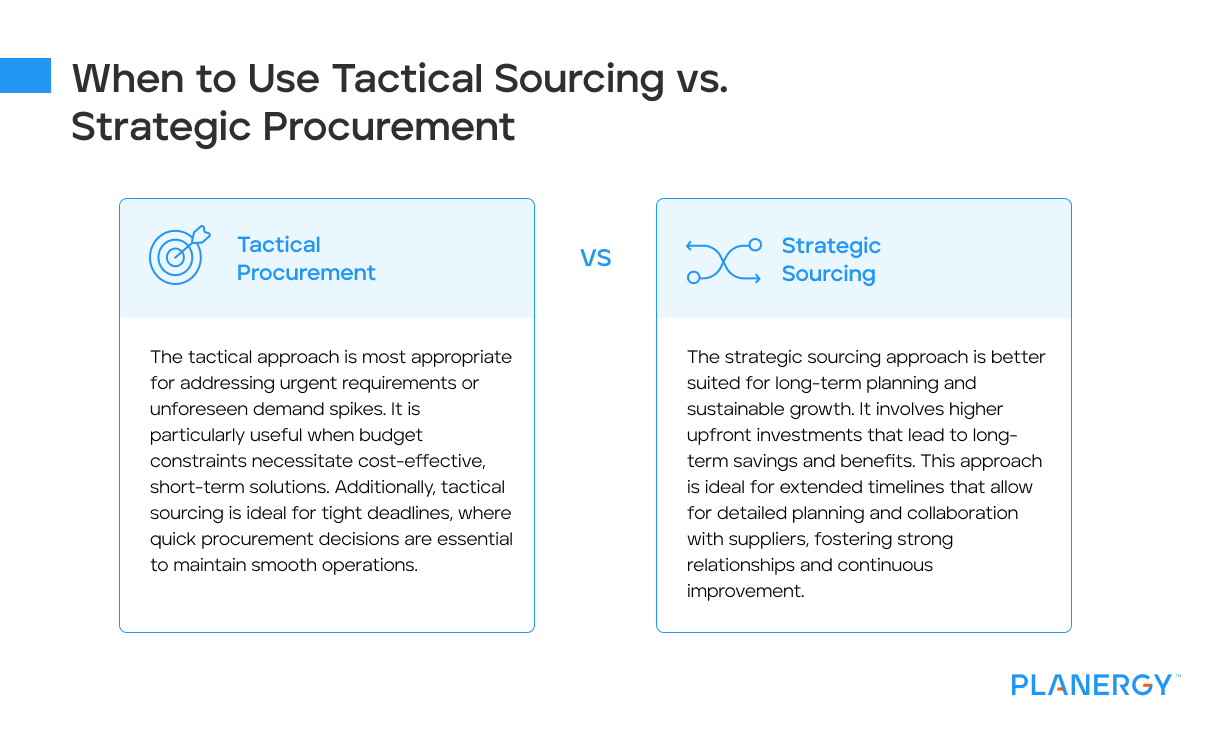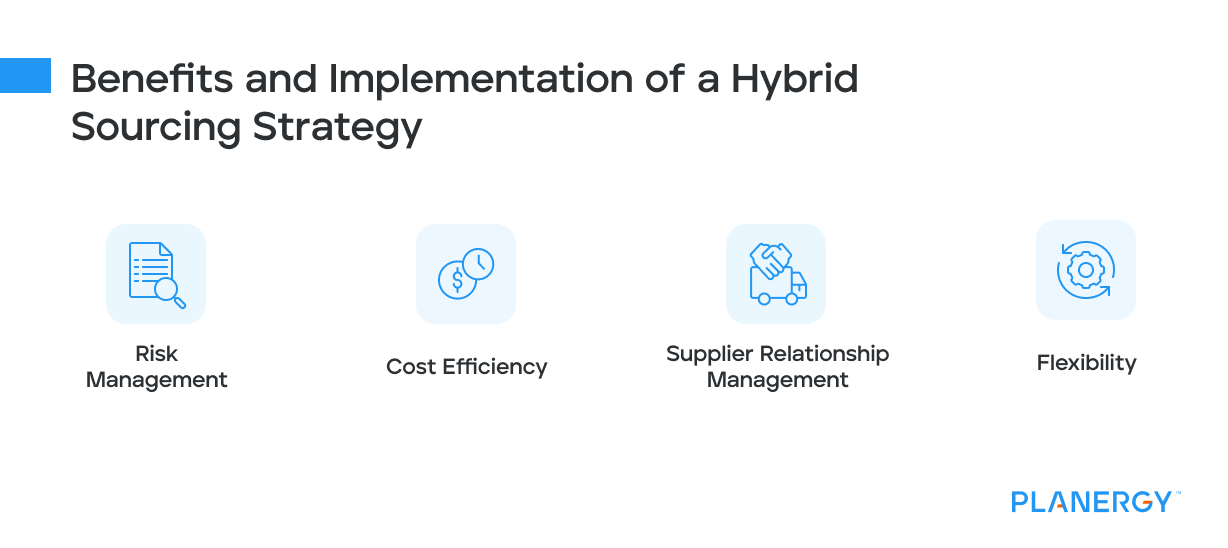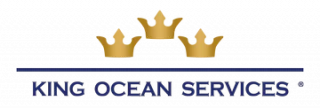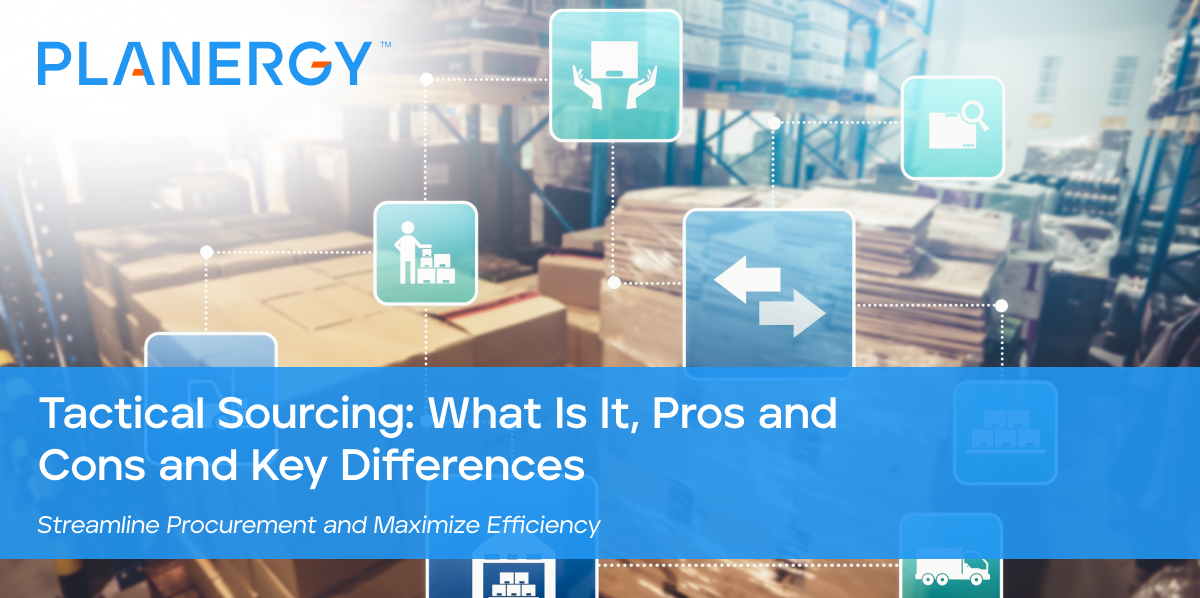Tactical sourcing plays a vital role in the procurement process by addressing immediate needs and ensuring quick responses to changing demands.
This article will delve into tactical sourcing, its responsibilities, differences from strategic sourcing, and when to use each approach.
We’ll also cover how to build a hybrid strategy for the best overall approach to supply chain management.
What is Tactical Sourcing?

Tactical sourcing is a reactive, short-term approach to procurement that focuses on meeting immediate needs.
It involves quick decision-making and swift execution to address urgent requirements.
Responsibilities in Tactical Sourcing

Negotiating with Suppliers
One of the core responsibilities in tactical sourcing is negotiating with suppliers.
This involves rapidly securing favorable terms and prices for goods or services.
Unlike strategic sourcing, which allows time for extensive negotiation and relationship building, tactical sourcing requires procurement professionals to act quickly.
The goal is to obtain the best possible deal under tight timelines, ensuring that the organization’s immediate needs are met with high-quality options.
Managing Vendor Relationships
Effective vendor management is crucial in tactical sourcing.
This responsibility includes maintaining robust communication channels with preferred suppliers, swiftly addressing issues, and ensuring timely deliveries.
Given the short-term nature of tactical sourcing, procurement specialists must be adept at managing multiple vendors simultaneously, often juggling last-minute changes and urgent requests.
Building and maintaining good relationships with vendors, even under pressure, is essential for successful tactical sourcing initiatives.
Purchasing Goods or Services
Another key responsibility in tactical sourcing is executing purchases efficiently. This involves the actual procurement of necessary items to avoid operational delays.
Tactical sourcing requires a streamlined purchasing process to ensure that goods or services are obtained quickly and cost-effectively.
Procurement professionals must handle urgent orders, process them accurately, and ensure prompt delivery.
This step is critical in preventing disruptions in the supply chain and maintaining smooth business operations.
Differentiating Tactical and Strategic Sourcing
Tactical and strategic sourcing represent two distinct approaches to procurement, each with its own characteristics and objectives.
Tactical sourcing focuses on short-term, immediate needs. It is a reactive and flexible approach designed to respond quickly to market changes and urgent demands.
The primary goal of tactical sourcing is to address pressing requirements swiftly and efficiently, making it ideal for situations where quick turnaround times are essential.
This approach emphasizes speed and adaptability, enabling procurement professionals to immediately secure necessary goods or services.
Strategic sourcing takes a long-term view, concentrating on building sustainable supplier partnerships.
It is a proactive and collaborative approach to fostering strong supplier relationships and identifying cost savings, cost reductions, and innovation opportunities through ongoing collaboration.
Strategic sourcing aims to create a stable and reliable supply chain that supports the organization’s broader business goals.
By investing time and resources into developing these relationships, businesses can achieve significant long-term benefits, such as improved supplier performance, reduced costs, and enhanced product quality.
While tactical sourcing is about achieving quick wins and addressing immediate challenges, strategic sourcing seeks to establish a foundation for long-term success and sustainability.
The Tactical Sourcing Process

Identifying Needs
Identify the immediate requirements for goods or services accurately.
This involves assessing the organization’s urgent needs and determining what must be procured to avoid disruptions in operations.
Clear and precise identification of needs ensures that the procurement team focuses on procuring the right items in the required quantities.
Sourcing Suppliers
Once the needs have been identified, the next step is to source suitable suppliers to meet these urgent demands.
This involves researching potential suppliers, evaluating their capabilities, and selecting those who deliver the required goods or services promptly based on the lead time that works best with your needs.
The selection criteria include delivery speed, reliability, cost-effectiveness, and the ability to meet quality standards.
Negotiating Contracts
After selecting the suppliers, the procurement team must swiftly negotiate contracts.
This step involves securing favorable terms, prices, and delivery timelines that align with the organization’s immediate needs.
Effective negotiation is crucial in tactical sourcing as it ensures that the organization receives the best possible deal under time constraints.
The focus is on achieving quick and efficient agreements that meet the situation’s urgency.
Executing Purchases
The final step in the tactical sourcing process is executing the purchases.
This involves placing orders, processing them accurately, and ensuring that the goods or services are delivered promptly.
Efficient execution is essential to prevent delays disrupting the organization’s operations.
This step requires meticulous attention to detail and supplier coordination to guarantee that procurement activities are completed smoothly and on time.
When to Use Tactical Sourcing vs. Strategic Procurement

Tactical Procurement
The tactical approach is most appropriate for addressing urgent requirements or unforeseen demand spikes.
It is particularly useful when budget constraints necessitate cost-effective, short-term solutions.
Additionally, tactical sourcing is ideal for tight deadlines, where quick procurement decisions are essential to maintain smooth operations.
Strategic Sourcing
The strategic sourcing approach is better suited for long-term planning and sustainable growth.
It involves higher upfront investments that lead to long-term savings and benefits.
This approach is ideal for extended timelines that allow for detailed planning and collaboration with suppliers, fostering strong relationships and continuous improvement.
Benefits and Implementation of a Hybrid Sourcing Strategy

Risk Management
A hybrid sourcing strategy effectively balances short-term risks with long-term stability.
By integrating tactical sourcing, businesses can respond swiftly to immediate needs and market fluctuations, reducing the risk of operational disruptions.
At the same time, strategic sourcing establishes strong supplier relationships that ensure consistent supply and support long-term business goals.
This dual approach mitigates risks, providing a comprehensive risk management framework.
Cost Efficiency
Cost efficiency is another significant benefit of a hybrid sourcing strategy.
Tactical sourcing addresses immediate needs at competitive prices, which helps manage short-term costs effectively.
On the other hand, strategic sourcing focuses on long-term savings through negotiated contracts and volume discounts for a lower total cost of ownership (TCO).
By combining these approaches, businesses can minimize costs in the short term while securing substantial savings over the long haul, creating a balanced and cost-effective procurement strategy.
Supplier Relationship Management
A hybrid approach fosters strong supplier partnerships that promote innovation and reliability.
Tactical sourcing enables quick responses to immediate needs, ensuring that suppliers are agile and responsive.
Strategic sourcing, meanwhile, builds long-term relationships with key suppliers, encouraging collaboration and continuous improvement.
Together, these strategies create a robust, adaptable, dependable supplier network, driving innovation and enhancing supply chain resilience.
Flexibility
Flexibility is a crucial advantage of a hybrid sourcing strategy.
This approach provides the agility to adapt to immediate market conditions through tactical sourcing while supporting strategic shifts and long-term planning.
Businesses can quickly pivot to address urgent requirements without compromising their overall strategic goals.
This flexibility ensures the procurement process remains dynamic and resilient in changing market landscapes.
Designing a Hybrid Sourcing Strategy
Identify Product Categories
The first step in designing a hybrid sourcing strategy is identifying product categories that fit into either tactical or strategic sourcing.
Generally, high-volume, low-value items are suited for tactical sourcing due to their frequent and variable demand.
Conversely, high-value, critical components are better managed through strategic sourcing, where long-term relationships and stability are paramount.
Clearly defining these categories ensures the right sourcing approach is applied to each product type.
Map Out Supplier Networks
Next, develop distinct supplier networks for each category.
Tactical suppliers should be prioritized based on their ability to deliver quickly and cost-effectively.
These suppliers are essential for meeting urgent demands efficiently.
On the other hand, strategic suppliers should be selected for their capability to build long-term relationships and add value through innovation and reliability.
Having distinct networks for tactical and strategic suppliers ensures that each category is managed appropriately.
Establish Processes and Workflows
Establishing clear processes for both sourcing types is crucial. Tactical processes should focus on streamlined requisition and order processes and be flexible to handle urgent demands effectively.
This includes having quick decision-making protocols and responsive procurement systems.
Strategic processes, in contrast, should be detailed and collaborative, focusing on long-term objectives such as continuous improvement and cost efficiency.
Clear processes for both approaches ensure that procurement activities are executed smoothly and effectively.
Consider using automation with procurement software to streamline the entire procure-to-pay process. It will also make tasks like contract management and spend analysis easier.
Performance Monitoring
Implement sustainable performance monitoring to track the effectiveness of the hybrid strategy. This involves tracking key performance indicators (KPIs) relevant to both tactical and strategic sourcing.
Utilize data analytics to assess supplier performance and overall sourcing efficiency.
Regular performance monitoring enables businesses to identify areas for improvement and ensure that the sourcing strategy remains aligned with business goals.
Continuous Evaluation and Adjustment
Review and adjust the hybrid strategy regularly based on performance data and market changes.
This continuous evaluation ensures that the strategy remains effective and responsive to evolving business needs.
Businesses can refine their sourcing approach, optimize procurement processes, and maintain a competitive edge by making data-driven adjustments.
Best Practices for Implementing a Hybrid Sourcing Strategy
Continual Communication
Maintain open lines of communication with all stakeholders, including suppliers, to ensure alignment and transparency.
Effective communication fosters collaboration and ensures that all parties are informed and engaged throughout the procurement process.
Supplier Collaboration
Engage suppliers in continuous improvement initiatives and innovation efforts.
Collaborating with suppliers drives innovation, improves quality, and enhances overall supply chain performance.
Training and Development
Equip your procurement team with the skills to effectively manage tactical and strategic sourcing.
Providing ongoing training and development ensures the team is well-prepared to execute the hybrid strategy successfully.
Technology Utilization
Leverage procurement technologies to streamline sourcing processes and enhance decision-making.
Advanced procurement tools and systems can improve the sourcing process’s efficiency, accuracy, and transparency.
Risk Mitigation Planning
Develop contingency plans to address potential risks in both tactical and strategic sourcing.
Robust risk mitigation plans ensure the organization can respond effectively to unforeseen challenges and maintain operational continuity.
By adopting a hybrid sourcing strategy, businesses can achieve a balanced approach to procurement that maximizes both immediate responsiveness and long-term strategic benefits.




